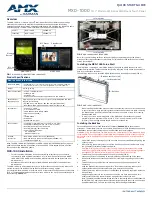
2
General Installation Manual
Safety Precautions
• All instructions should be read and
understood before attempting to
install, wire, operate, and maintain
the module.
• The installation of modules
requires a great degree of skill
and should only be performed by
qualified licensed professionals,
including, without limitation,
licensed contractors and licensed
electricians.
• The installer assumes the risk of
all injury that might occur during
installation, including, without
limitation, the risk of electric
shock.
• Before installing modules, contact
the appropriate authorities to
determine permissions, installation
and inspection requirements,
which should be followed.
• Be sure that the construction or
structure (roof, etc.) where the
modules are being installed has
enough strength.
• Both roof construction and
module installation design have
an effect on the fire resistance of
a building. Improper installation
may contribute to fire hazards.
Additional devices such as ground
fault, fuses, and disconnects may
be required.
• For a non-integral module or
module, the assembly is to be
mounted over a fire resistant roof
covering rated for the application.
• For modules mounted on roofs,
special construction or structures
may be required to help provide
proper installation support.
• Do not install the module where
flammable gases or vapors are
present.
• Do not use modules of different
specifications in the same system.
• Follow all safety precautions of
other system components used.
• In some areas, local electrical
codes may govern the installation
and use of modules.
WARNING
To avoid the hazard of electric shock,
sparks, fire and injury
• The modules generate DC
electrical energy when exposed to
sunlight or other light sources, so
cover the entire front surface of
the modules with a dense, opaque
material such as a cardboard box,
during installation and handling of
the modules.
• The shock hazard increases as
modules are connected in parallel,
producing higher current, and as
modules are connected in series,
producing higher voltages.
• The shock hazard increases as
modules rated for maximum
system voltage in excess of 50 V.
• Wear suitable clothing, gloves
and guards to prevent from direct
contact with 30 VDC or greater.
• Work only in dry conditions, with
dry modules and dry tools.
• Children and unauthorized persons
should not be allowed near the
installation of modules.
• Do not puncture or damage the
backsheet of a module. Do not
use the PV module and make
a replacement, when scratch
exposing conductive part is found
on the backsheet.
• Do not disassemble the module, or
remove any parts installed by the
manufacturer.
• Do not open a junction box’s lid.
• Do not touch the junction box
terminals.
• Do not change the wiring of bypass
diodes.
• Do not connect or disconnect
terminals while modules generate
electricity and connect electrical
load.
• Never leave a module unsupported
or unsecured.
CAUTIONS
To avoid the hazard of injury, burn and
damage to the module
• Use a module for its intended
purpose only.
• Be sure that all other system
components are compatible, and
they do not subject the module to
mechanical or electrical hazards.
• Do not artificially concentrate
sunlight on a module.
• Do not stand or step on a module.
• When carrying a module, two or
more people should carry it by its
frame and wear non-slip gloves.
• Do not carry a module by its wires
or junction box.
• Do not drop a module.
• Do not drop anything on the surface
of a module.
• Do not hit the back side of a
module by the connector or
other object. Back side is easily
damaged.
• Do not stack anything on back side
of module.
• Do not disassemble a module,
attempt any repair, open the
junction box cover, nor remove
any parts installed by Panasonic.
There are no user serviceable parts
within the module or junction box.
• Do not treat the back sheet or front
surface with paint or adhesives.
• Do not use or install broken
modules. If you find a breakdown
such as glass breakage, contact
the professional installer to replace
it promptly.
• Do not touch a module
unnecessarily. The glass surface
and frames get hot.




































